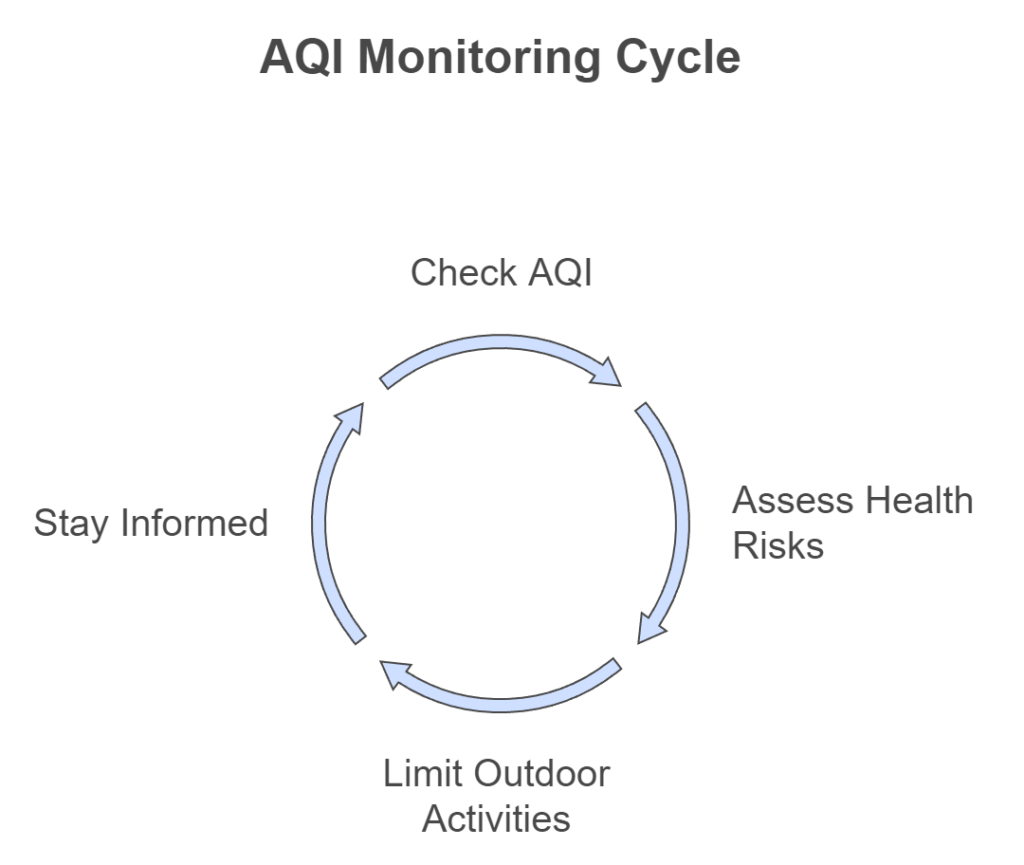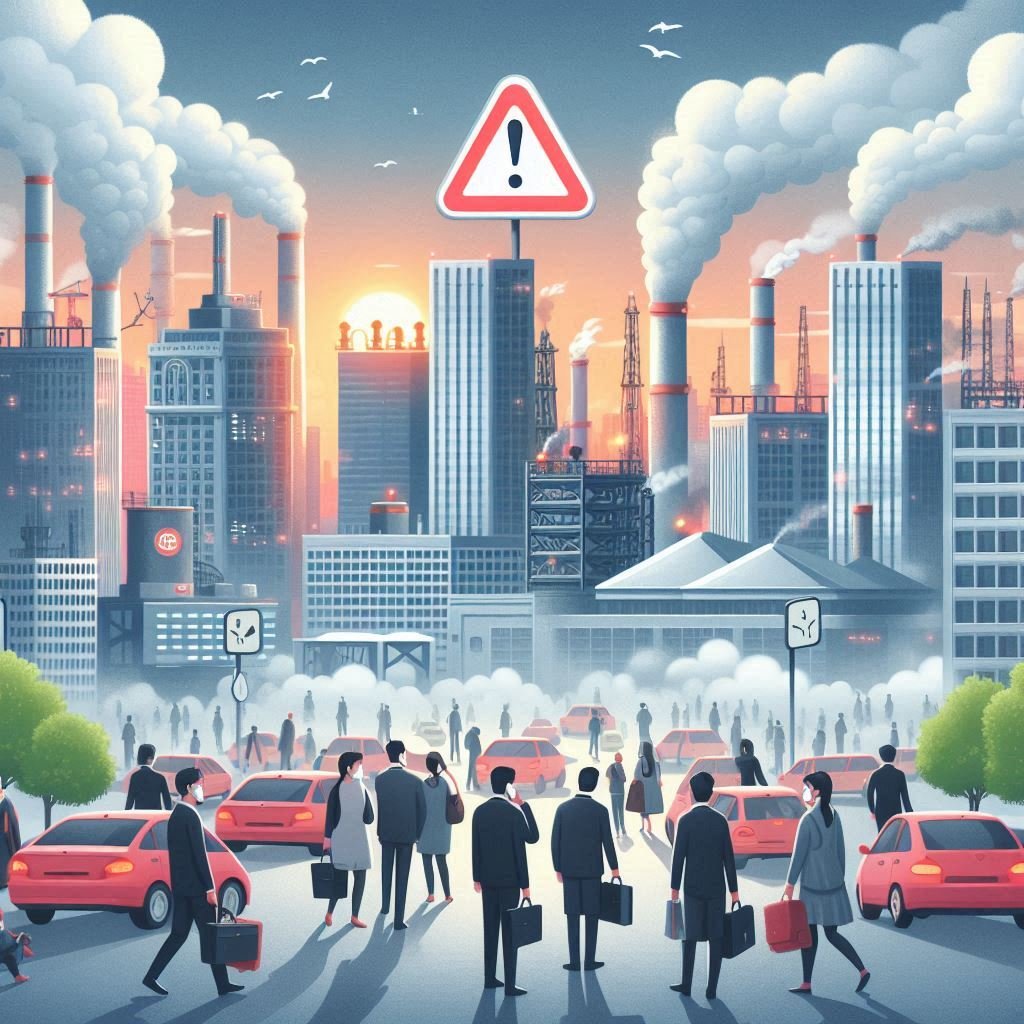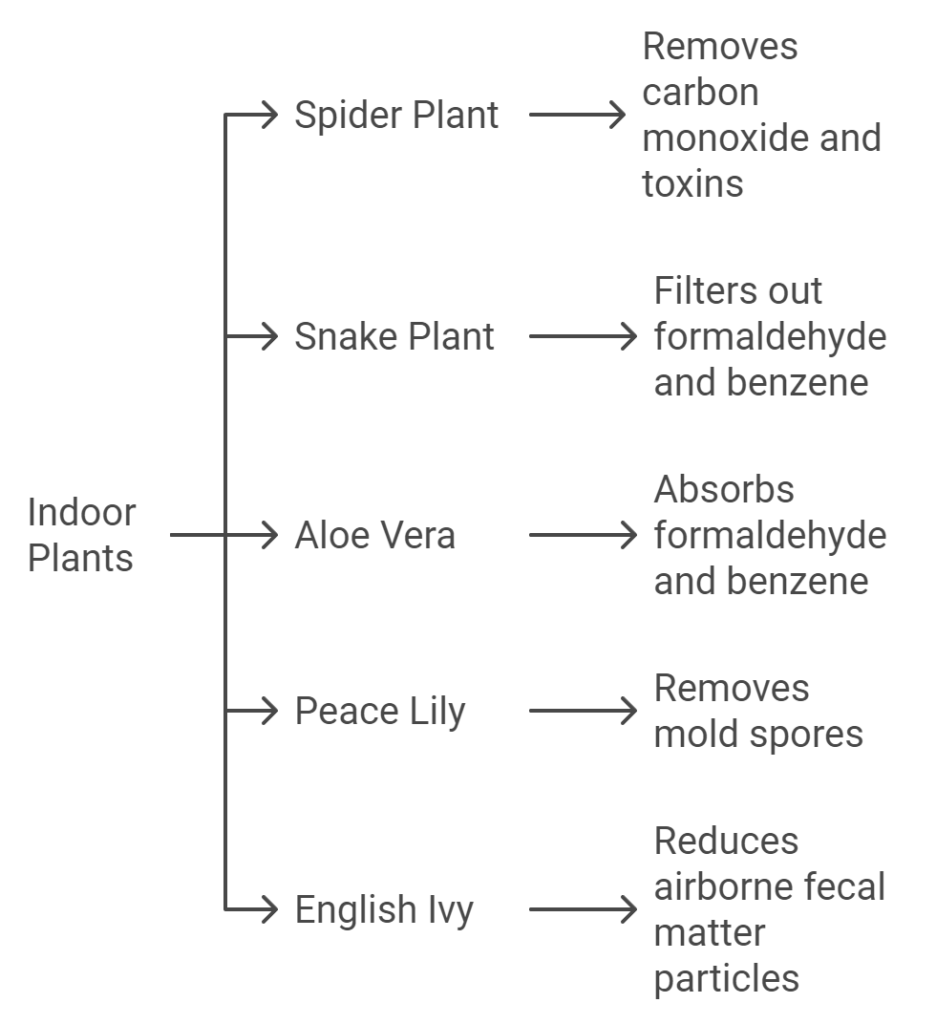
Table of Content
I. Introduction
II. The Current State of Air Quality in Baghdad
III. Causes of the Air Quality Emergency
IV. Health Impacts of Poor Air Quality
V. Eco-Friendly Practices to Combat Air Pollution
VI. Sustainable Solutions for Homeowners
VII. Empowering Parents: Protecting Children from Air Pollution
VIII. Call to Action
IX. Conclusion
X. FAQs
I. Introduction
Understanding the Toxic Cloud Over Baghdad
The Toxic Cloud Over Baghdad is not just a headline; it is a reality. Baghdad’s air quality has taken a severe hit due to industrial emissions and vehicle pollution. These pollutants create a thick, hazardous cloud that hovers over the city. This toxic cloud poses significant health risks, especially for children and the elderly.
Importance of Addressing Air Quality
Addressing air quality is crucial for the well-being of Baghdad’s residents. Poor air quality impacts daily life and long term health. Respiratory problems, allergies, and chronic illnesses are on the rise. Homeowners and parents must take proactive steps to protect their families.
Eco-Friendly Practices and Sustainable Solutions
Eco-friendly practices and sustainable solutions are not only beneficial for the environment but also for our health. Simple changes can make a big difference. Reducing indoor pollution, using air purifiers, and engaging in community initiatives can help. These efforts collectively improve the air quality and create a healthier living environment.
Purpose of This Blog Post
The purpose of this blog post is to inform, engage, and empower you. We will explore the causes of Baghdad’s toxic air crisis and its health impacts. You will discover practical, eco-friendly solutions for your home and family. Together, we can combat the toxic cloud over Baghdad and ensure a safer future for everyone.

II. The Current State of Air Quality in Baghdad
Air Quality Index (AQI) Explained
The Air Quality Index (AQI) effectively communicates the current level of air pollution or predicts how polluted the air will-become. The AQI transforms complex air quality data into a simple color-coded scale. This scale makes it easier for the public to understand the potential health impact.
Key Points About AQI:
- 0-50 (Good): Air quality is satisfactory.
- 51-100 (Moderate): Air quality is acceptable; however, some pollutants may affect a small number of sensitive individuals.
- 101-150 (Unhealthy for Sensitive Groups): Members of sensitive groups may experience health effects.
- 151-200 (Unhealthy): Everyone may begin to experience health effects; sensitive groups may experience more serious effects.
- 201-300 (Very Unhealthy): Health alert; everyone may experience serious health effects.
- 301-500 (Hazardous): Health warning of emergency conditions; the entire population is more likely to be affected.
Recent AQI Readings in Baghdad
The air quality in Baghdad has been alarmingly poor in recent months. The city’s AQI levels have frequently reached unhealthy levels, posing significant health risks to its residents.
| Month | Average AQI | Quality Status |
|---|---|---|
| July | 160 | Unhealthy |
| August | 175 | Unhealthy |
| September | 190 | Unhealthy |
| October | 210 | Very Unhealthy |
Baghdad’s recent AQI readings indicate that the city often experiences hazardous air quality conditions. It is essential for homeowners and parents to stay informed about daily AQI levels to protect their families.
The Importance of Monitoring AQI
Regularly monitoring the AQI can help you take necessary precautions. For example, on days when the AQI is high, limit outdoor activities to protect your health, especially for children and the elderly. Breathing clean air is fundamental to health. It’s important to stay informed and take action based on AQI readings.
By understanding the Air Quality Index and its implications, residents of Baghdad can better navigate the challenges posed by poor air quality and take practical steps to ensure a healthier living environment.

III. Causes of the Air Quality Emergency
Industrial Emissions
Industrial emissions are a significant contributor to Baghdad’s air pollution. Factories release a vast amount of pollutants into the air. These include sulfur dioxide, nitrogen oxides, and volatile organic compounds (VOCs). These pollutants come from manufacturing processes, energy production, and chemical plants.
Key Pollutants from Industries:
- Sulfur Dioxide (SO2): Causes respiratory issues and acid rain.
- Nitrogen Oxides (NOx): Lead to smog and respiratory problems.
- Volatile Organic Compounds (VOCs): Contribute to ozone formation and health risks.
Industrial emissions are a critical concern for urban air quality.
Vehicle Pollution
Vehicle emissions are another major source of air pollution in Baghdad. Cars, trucks, and buses emit harmful pollutants like carbon monoxide, nitrogen oxides, and particulate matter.
Effects of Vehicle Emissions:
- Carbon Monoxide (CO): Reduces oxygen delivery to the body’s organs.
- Nitrogen Oxides (NOx): Contribute to the formation of ground-level ozone.
- Particulate Matter (PM): Tiny particles that can penetrate deep into the lungs.
Table: Vehicle Pollution and Its Impact
| Pollutant | Source | Health Effects |
|---|---|---|
| Carbon Monoxide | Vehicle exhaust | Headaches, reduced oxygen levels, heart issues |
| Nitrogen Oxides | Combustion engines | Respiratory problems, smog formation |
| Particulate Matter | Engine combustion, tire wear | Lung damage, cardiovascular diseases |
Dust Storms
Dust storms are natural phenomena that worsen Baghdad’s air quality. These storms carry fine dust particles that can cause visibility issues and health problems.
Impact of Dust Storms:
- Respiratory Issues: Dust particles can irritate the respiratory system.
- Visibility Reduction: Dust reduces visibility, leading to accidents.
- Health Risks: Prolonged exposure can lead to chronic respiratory conditions.
Dust storms are a natural but significant contributor to air pollution.
Waste Burning
Improper waste disposal and burning are rampant issues. Open burning of waste releases toxic pollutants, including dioxins, furans, and heavy metals.
Consequences of Waste Burning:
- Dioxins and Furans: Carcinogens that can affect immune and reproductive systems.
- Heavy Metals: Lead and mercury can cause severe health problems.
List: Safe Waste Disposal Practices
- Use designated disposal sites.
- Recycle whenever possible.
- Avoid burning waste openly.
By addressing these primary causes, we can work towards improving Baghdad’s air quality. Practical actions from homeowners and community initiatives are essential steps towards a cleaner, healthier environment.

IV. Health Impacts of Poor Air Quality
Respiratory Issues
Bad air quality in Baghdad directly affects the respiratory system. Pollutants such as particulate matter, sulfur dioxide, and nitrogen oxides can penetrate deep into the lungs. This results in various respiratory problems.
Common Respiratory Problems:
- Asthma: Polluted air triggers asthma attacks.
- Bronchitis: Inflammation of the bronchial tubes.
- Chronic Obstructive Pulmonary Disease (COPD): Long-term exposure leads to serious lung conditions.
- Pneumonia: Increased susceptibility to lung infections.
- Shortness of Breath: Difficulty breathing due to particulate matter.
Impact on Children and the Elderly
Children and the elderly are particularly vulnerable to poor air quality. Their respiratory systems are either still developing or weakening, making them more susceptible to pollutants.
Impact on Children:
- Higher rates of asthma and bronchitis.
- Impaired lung development.
- An increase in school absences due to respiratory illnesses.
Impact on the Elderly:
- Exacerbation of pre-existing respiratory conditions.
- Higher risk of hospital admissions.
- Elevated mortality rates associated with respiratory and cardiovascular diseases.
Table: Health Impacts on Different Age Groups
| Age Group | Health Impacts |
|---|---|
| Children | Asthma, bronchitis, impaired lung development |
| Adults | Increased respiratory issues, COPD, pneumonia |
| Elderly | Exacerbation of conditions, higher hospitalization |
Long-Term Health Consequences
Extended exposure to poor air quality poses substantial long-term health risks. Persistent exposure to pollutants leads to chronic health conditions and impacts overall quality of life.
Long-Term Health Risks:
- Cardiovascular Diseases: Increased risk of heart attacks and strokes.
- Lung Cancer: Higher risk due to long-term inhalation of carcinogenic pollutants.
- Premature Death: Shortened lifespan due to chronic exposure.
- Chronic Respiratory Diseases: Ongoing respiratory issues and lung damage.
- Impact on Mental Health: Increased stress and anxiety levels due to health concerns.
Chronic exposure to polluted air can have devastating effects on health, increasing the risk of serious diseases and reducing life expectancy.
Understanding the health impacts of poor air quality empowers homeowners and parents to take protective measures. By improving indoor air quality and advocating for cleaner air, we can mitigate these health risks and ensure a healthier environment for everyone.

V. Eco-Friendly Practices to Combat Air Pollution
Green Home Solutions
Adopting eco-friendly home solutions can significantly reduce your carbon footprint and improve air quality. Simple adjustments can lead to a healthier home environment.
List of Eco-Friendly Home Adjustments:
- Use Energy-Efficient Appliances: Energy-efficient appliances consume less power and reduce emissions.
- Install Solar Panels: Solar panels provide renewable energy and lower reliance on fossil fuels.
- Opt for LED Lighting: LED lights are energy-efficient and have a longer lifespan.
- Insulate Your Home: Proper insulation reduces energy consumption for heating and cooling.
- Plant a Home Garden: Plants improve air quality by absorbing pollutants and producing oxygen.
Reducing Indoor Pollution
Indoor air can be more polluted than outdoor air. Implementing practical tips can help minimize indoor pollution and ensure a healthier living space.
Practical Tips to Minimize Indoor Pollutants:
- Ventilate Regularly: Open windows to allow fresh air to circulate.
- Use Natural Cleaning Products: Avoid harsh chemicals that release volatile organic compounds (VOCs).
- Avoid Synthetic Fragrances: Opt for natural air fresheners like essential oils.
- Use Air Purifiers: Invest in a quality air purifier to remove indoor pollutants.
- Keep Indoor Plants: Plants like aloe vera and spider plants can help clean indoor air.
Community Initiatives
Community efforts are essential in improving air quality on a larger scale. Participating in or initiating local projects can have a significant impact.
Encouraging Community Efforts:
- Organize Tree Planting Drives: Trees absorb CO2 and produce oxygen.
- Promote Public Transportation: Encourage the use of buses and trains to reduce vehicle emissions.
- Start Recycling Programs: Implement and support recycling initiatives in your community.
- Conduct Air Quality Awareness Campaigns: Educate others about the importance of air quality and how to improve it.
Community involvement is crucial for sustainable environmental change. Together, we can achieve cleaner air for everyone.
By adopting these eco-friendly practices and engaging in community initiatives, homeowners and parents can play a vital role in combating air pollution. Small changes at home and active participation in local efforts can lead to a significant improvement in the air we breathe.

VI. Sustainable Solutions for Homeowners
Using Air Purifiers
Air purifiers are a must-have for maintaining clean indoor air. They remove pollutants and allergens, improving overall air quality.
Types of Air Purifiers:
- HEPA Filters: Capture 99.97% of airborne particles. Ideal for asthma and allergy sufferers.
- Activated Carbon Filters: Remove odors, VOCs, and gases. Great for homes near industrial areas.
- UV Air Purifiers: Use ultraviolet light to kill bacteria and viruses. Perfect for reducing germs.
- Ionic Purifiers: Release negative ions to remove particles. Suitable for reducing smoke and dust.
Investing in a quality air purifier is crucial for a healthy home environment.
Table: Comparison of Air Purifiers
| Type | Key Feature | Ideal For |
|---|---|---|
| HEPA Filters | High particle capture rate | Allergy and asthma relief |
| Activated Carbon Filters | Odor and gas removal | Homes near industrial areas |
| UV Air Purifiers | Kills bacteria and viruses | Reducing germs |
| Ionic Purifiers | Reduces smoke and dust | General air cleanliness |
Indoor Plants for Clean Air
Indoor plants are natural air purifiers. They absorb toxins and release oxygen, creating a healthier indoor environment.
List of Indoor Plants That Improve Air Quality:
- Spider Plant: Removes carbon monoxide and toxins.
- Snake Plant: Filters out formaldehyde and benzene.
- Aloe Vera: Absorbs formaldehyde and benzene.
- Peace Lily: Removes mold spores from the air.
- English Ivy: Reduces airborne fecal matter particles.
Indoor plants not only beautify your home but also provide natural air purification.
Benefits of Indoor Plants

Energy-Efficient Appliances
Switching to energy-efficient appliances reduces energy consumption and lowers utility bills. These appliances are designed to perform better while using less power.
Recommended Energy-Efficient Appliances:
- Refrigerators: Look for ENERGY STAR rated models.
- Washing Machines: Front-loading models use less water and energy.
- Dishwashers: Choose models with eco-friendly wash cycles.
- Ovens and Stoves: Induction cooktops are energy-efficient and safer.
- Lighting: Use LED bulbs for long-lasting and energy-efficient lighting.
Choosing energy-efficient appliances can significantly reduce your home’s energy use and environmental footprint.
Table: Energy-Efficient Appliance Benefits
| Appliance Type | Benefit |
|---|---|
| Refrigerators | Lower energy consumption |
| Washing Machines | Reduced water and energy use |
| Dishwashers | Eco-friendly wash cycles |
| Ovens and Stoves | Efficient cooking and safety |
| Lighting | Long-lasting, low energy use |
By adopting these sustainable solutions, homeowners can create a healthier and more environmentally friendly living space. Each step, from using air purifiers to choosing energy-efficient appliances, contributes to a cleaner, more sustainable home environment.

VII. Empowering Parents: Protecting Children from Air Pollution
Safe Outdoor Activities
Poor air quality doesn’t mean children should stay indoors all the time. There are ways to ensure they enjoy outdoor activities safely.
Suggestions for Safe Outdoor Activities:
- Morning Walks: Air quality tends to be better in the morning. Opt for walks before traffic picks up.
- Parks with Green Spaces: Trees and plants help filter the air. Choose parks with ample greenery.
- Indoor to Outdoor Transitions: On days with better air quality, gradually increase outdoor time.
- Activities in Covered Areas: Utilize sports facilities with covered areas to shield from direct exposure.
- Seasonal Adjustments: Prefer outdoor activities during seasons when air quality is generally better, like after rains.
Ensuring children have safe outdoor options despite air pollution is crucial for their well-being.
Indoor Play Solutions
Indoor activities are essential, especially when outdoor air quality is poor. Creative indoor play keeps children active and engaged.
Recommended Indoor Activities and Play Options:
- DIY Crafts and Art Projects: Encourage creativity with recyclable materials.
- Indoor Sports: Set up mini sports like basketball or soccer in the living room.
- Educational Games: Utilize board games and puzzles to stimulate their minds.
- Storytime and Reading: Create a cozy reading nook and explore new books.
Table: Indoor Activities to Keep Children Engaged
| Activity | Benefits |
|---|---|
| DIY Crafts | Enhances creativity and fine motor skills |
| Indoor Sports | Promotes physical activity |
| Educational Games | Boosts cognitive development |
| Storytime | Encourages a love for reading |
Health Monitoring Tips
Regular health monitoring is essential to protect children from the adverse effects of air pollution. Staying vigilant helps catch any issues early.
Tips for Monitoring and Maintaining Children’s Health:
- Monitor Respiratory Symptoms: Watch for signs of coughing, wheezing, and shortness of breath.
- Regular Medical Checkups: Schedule routine visits to the pediatrician for checkups.
- Healthy Diet: Ensure they eat a balanced diet rich in antioxidants.
- Hydration: Keep them well-hydrated to help their bodies combat pollutants.
- Air Quality Awareness: Use air quality apps to stay informed and plan activities accordingly.
Parents play a key role in monitoring and safeguarding their children’s health against air pollution.
List: Essential Items for Health Monitoring
- Digital Thermometer
- Peak Flow Meter
- Air Quality Monitor
- Humidifier
- First Aid Kit
By following these guidelines, parents can create a safe and healthy environment for their children, even amid concerns about air pollution. Staying proactive and informed ensures that children can thrive regardless of external air quality conditions.

VIII. Call to Action
Community Engagement
Taking action starts at the community level. Engage in local environmental efforts to create a healthier and cleaner Baghdad. Community participation not only enhances the effectiveness of these initiatives but also fosters a sense of shared responsibility and achievement.
Ways to Get Involved in Local Environmental Efforts:
- Join Tree Planting Campaigns: Trees absorb CO2 and release oxygen, improving air quality.
- Participate in Clean-Up Drives: Help clean public spaces to reduce waste and pollution.
- Support Local Eco-Friendly Businesses: Choose products and services from businesses that prioritize sustainability.
- Attend Environmental Workshops: Gain knowledge and skills to contribute more effectively to green initiatives.
- Organize Awareness Programs: Educate others about the importance of air quality and sustainable practices.
By engaging in these activities, individuals can make a significant impact on improving air quality and enhancing the overall environment. Your involvement matters.
Advocating for Policy Changes
Advocating for environmental policies is crucial to creating long-term solutions. Policy changes can bring about structural changes needed to address the root causes of poor air quality.
Importance of Advocating for Environmental Policies:
- Stricter Emission Regulations: Push for policies that limit industrial and vehicular emissions.
- Support for Renewable Energy: Advocate for investments in renewable energy sources to reduce reliance on fossil fuels.
- Improved Waste Management: Encourage policies that promote proper waste disposal and recycling.
- Public Transportation Initiatives: Support the development of sustainable public transportation options to reduce vehicle emissions
- Green Building Standards: Advocate for building codes that require energy-efficient and environmentally friendly construction practices.
Table: Policy Changes to Improve Air Quality
| Policy Initiative | Expected Impact |
|---|---|
| Stricter Emission Regulations | Reduced industrial and vehicular pollution |
| Renewable Energy Investments | Lower carbon footprint and cleaner energy |
| Enhanced Waste Management | Decreased air and land pollution |
| Sustainable Public Transportation | Reduced traffic emissions |
| Green Building Standards | Energy-efficient and healthier buildings |
Policy changes are essential to ensure sustainable and lasting improvements in air quality.
Advocate for these policies by contacting local representatives, participating in public forums, and supporting environmental organizations. Your voice can lead to meaningful change and a healthier future for Baghdad.
Engage actively and advocate persistently. Together, we can combat the toxic cloud over Baghdad and ensure a sustainable and healthy environment for everyone.
IX. Conclusion
Recap and Motivation
The air quality crisis in Baghdad is a serious issue that demands our immediate attention. We explored the current state of air quality, including the concerning AQI levels. We delved into the causes, highlighting industrial emissions, vehicle pollution, dust storms, and waste burning. Understanding these factors helps us address the root of the problem.
We also discussed the health impacts of poor air quality, focusing on respiratory issues, and the specific risks to children and the elderly. Long-term exposure can lead to severe health conditions, emphasizing the urgency of our actions.
We identified eco-friendly practices and sustainable solutions that can be implemented at home. From using air purifiers and planting indoor plants to adopting energy-efficient appliances, every small step counts. Moreover, engaging in community initiatives and advocating for policy changes can drive significant improvements.
Taking Practical Steps: It’s crucial to take practical steps to protect your family. Monitor the AQI, use air-purifiers, and involve your community in clean-up drives. Advocate for stricter environmental policies to ensure a long-term solution.
By adopting these measures, you contribute to a cleaner, healthier environment for Baghdad. Protecting your family and communitystarts with informed and proactive steps. Together, we can combat the toxic cloud over Baghdad and ensure a brighter, healthier future for everyone.
Let’s make a difference. Start today—your actions matter.
Subscribe to Eco-Safe Home
Stay informed and take proactive steps towards a healthier home environment by subscribing to the Eco-Safe Home website. By subscribing, you gain access to exclusive tips, updates, and a supportive community dedicated to eco-friendly practices and sustainable solutions.
Benefits of Subscribing:
- Expert Advice: Receive regular tips from environmental and health experts.
- Community Support: Join a network of like-minded individuals committed to making positive changes.
- Latest Updates: Stay up-to-date with the latest news and innovations in sustainability and home health.
- Practical Solutions: Get actionable insights and solutions to reduce indoor pollutants and improve air quality.
“Empowering our community with knowledge and support is the first step towards a sustainable future,” says Eco-Safe Home founder, Dr. Ghassan al Kaisy.
X. FAQs
1. What is the main cause of poor air quality in Baghdad?
The primary contributors include industrial emissions, vehicle pollution, dust storms, and waste burning. Each of these factors releases harmful pollutants into the air, exacerbating the city’s air quality issues.
2. How can I protect my family from poor air quality?
You can use air purifiers, keep indoor plants, monitor AQI levels, and reduce indoor pollutants by using natural cleaning products and ventilating your home regularly.
3. What are the health risks associated with long-term exposure to bad air quality?
Long-term exposure can lead to chronic respiratory diseases, cardiovascular issues, lung cancer, and increased risk of premature death. Children and the elderly are particularly vulnerable.
4. What are some eco-friendly practices to improve air quality at home?
Implement green home solutions like energy-efficient appliances, indoor plants, proper insulation, and natural cleaning products. Engage in community initiatives like tree planting and clean-up drives.
5. How can I get involved in improving air quality in my community?
Participate in local environmental efforts, advocate for policy changes, support eco-friendly businesses, and join awareness programs. Community engagement is crucial for making a significant impact.
References
- World Health Organization (WHO) – Air Quality and Health: WHO Air Quality
- Air Now – Air Quality Index (AQI) Basics
- United Nations Environment Programme (UNEP) – About Air
- National Geographic – Articles on Air Pollution: National Geographic
- Estimating the health risks associated with air pollution in Baghdad City, Iraq, link.springer.com/article/10.1007/s10661-014-4203-x
- Traffic and outdoor air pollution levels near highways in Baghdad, Iraq, link.springer.com/article/10.1007/s10668-016-9900-x